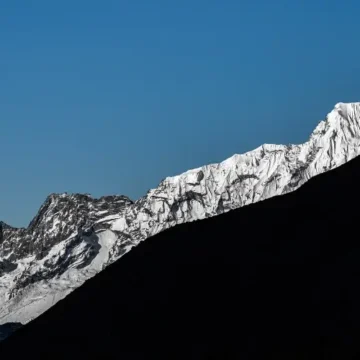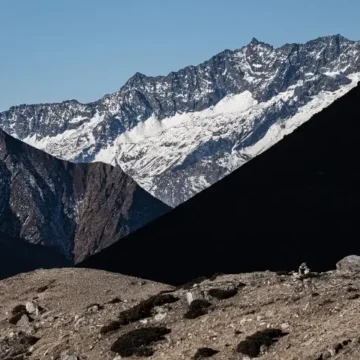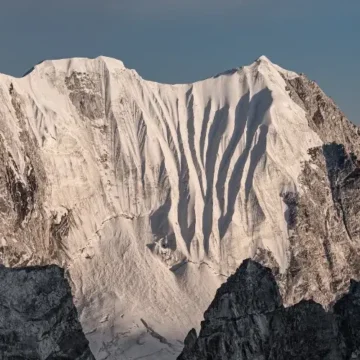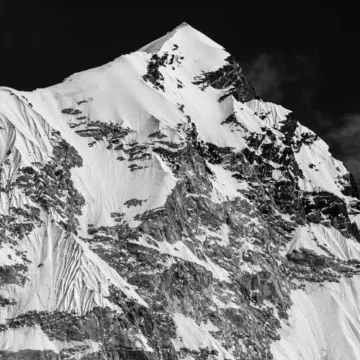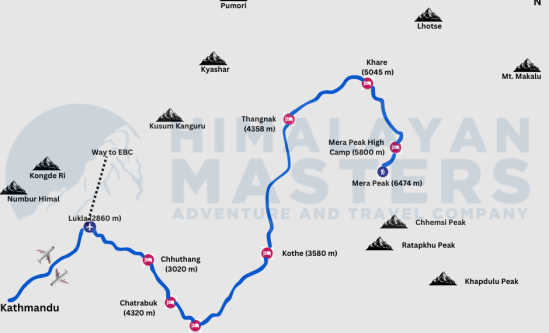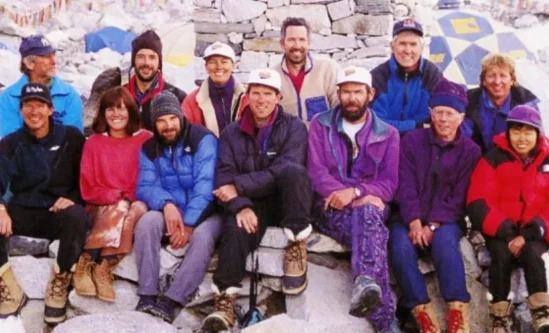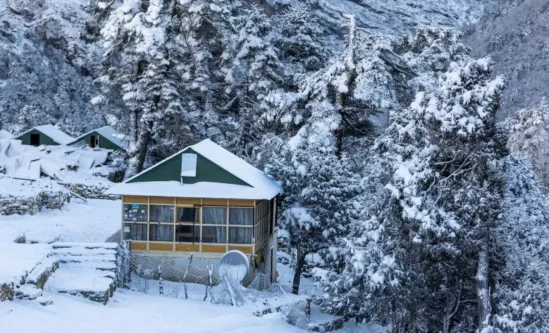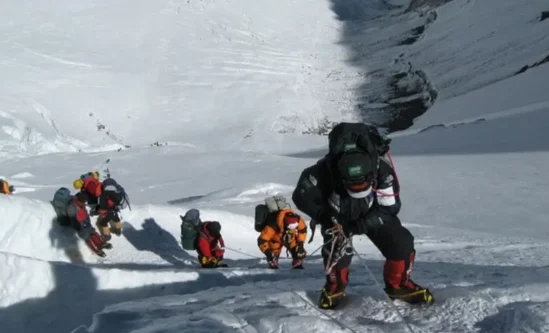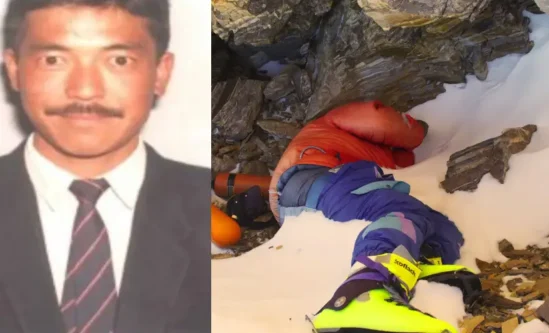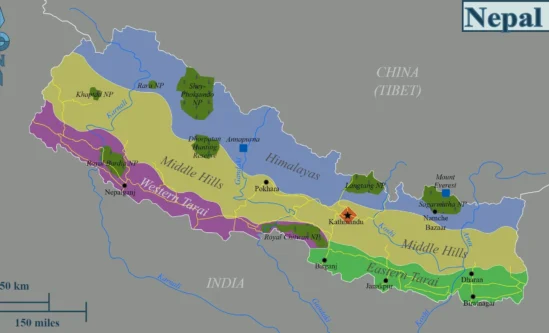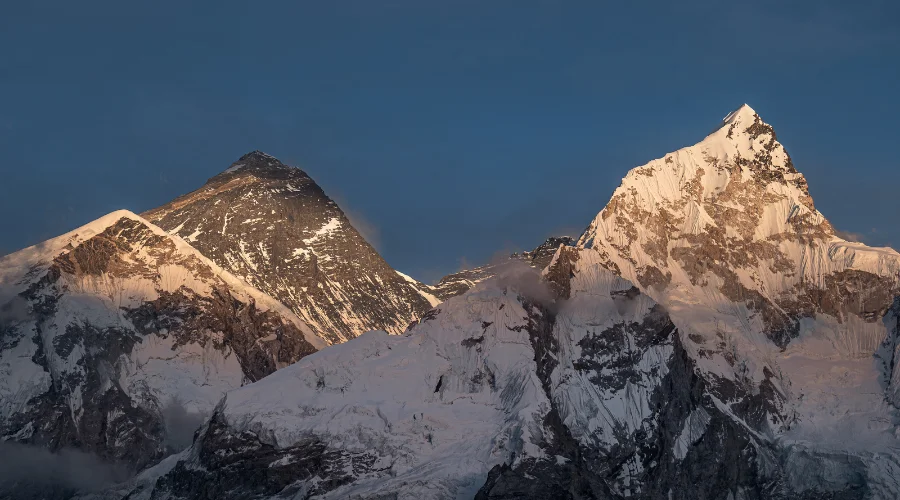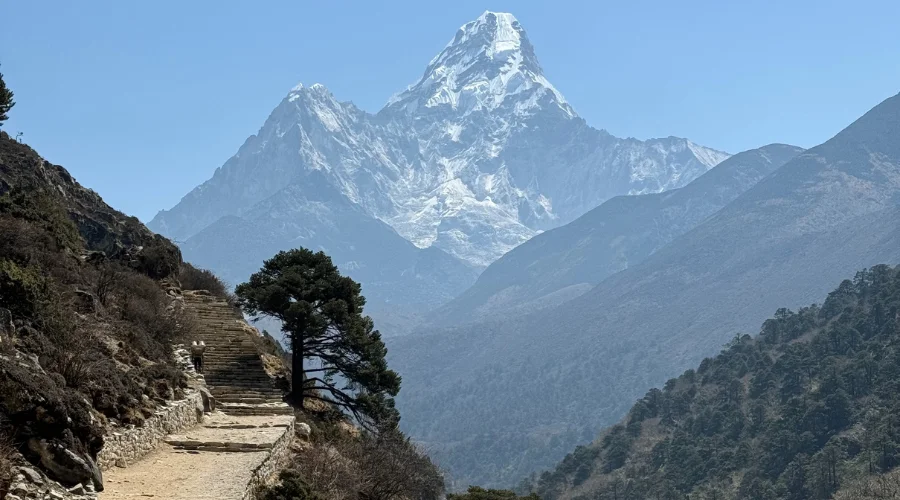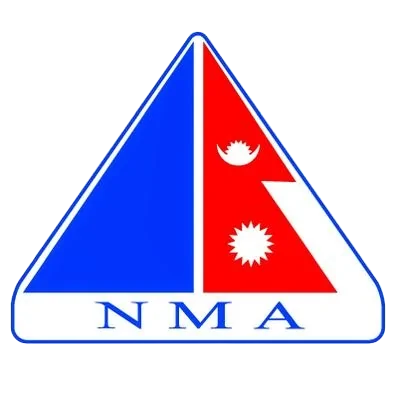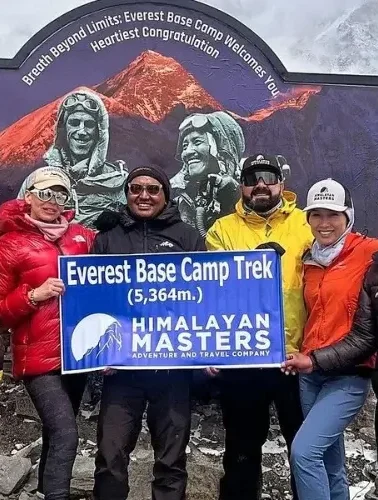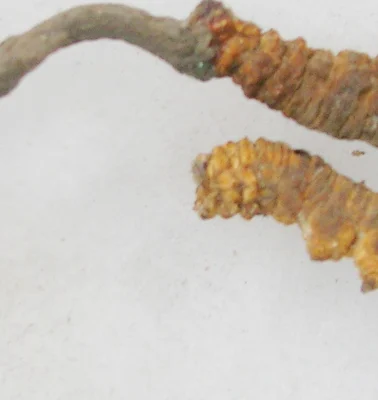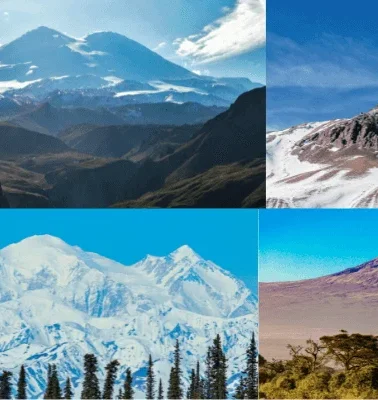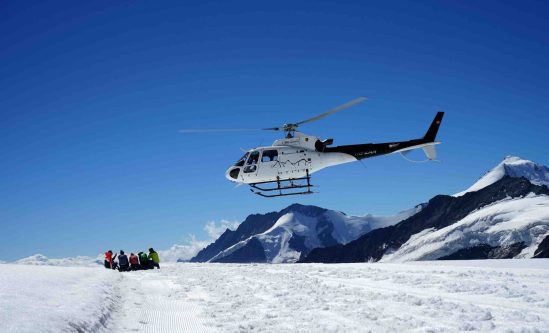
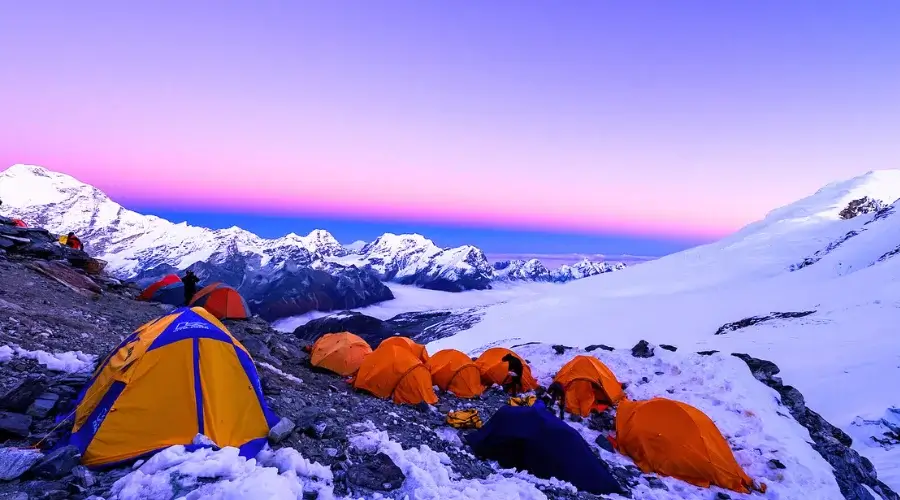
- TRIP DURATION
- 14 Days
- MAX. ALTITUDE
- 6,476 m (21,247 ft.)
- TRIP GRADE
- Difficult
- LODGING
- Tea House and Tent
- BEST SEASON
- Springs and Autumn
- MEALS
- Breakfast, Lunch & Dinner
- COMMUNICATION
- Local SIM Card
- PER DAY WALK
- 5 to 6 Hours
Mera Peak Climbing – 14 Days Itinerary
Lying next to Mount Everest lies the highest trekking peak in Nepal. It is no wonder Mera Peak climbing has been the most popular among the peaks in Nepal for trekking. The possibility of climbing a mountain with at least minimum trekking experience makes the place command quite a crowd.
An award-worthy feeling, we must say. Mera Peak, located 6,476 meters from sea level, is the highest you can go without mountain climbing permits. The Mera Peak Climbing is ideal for experienced trekkers and fresh climbers.
Mera would also form a good practice peak for anyone who intends to conquer other high peaks in Nepal above 8,000 meters. Most importantly, you can enjoy without paying thousands of dollars for a climbing permit; Mera Peak climbing rates are more affordable. This short, 14-day journey gives you full natural and cultural experiences.
Overview
Mera Peak Climbing is among the most famous Nepalese adventures, popularly known for its thrilling views and nontechnical ascent. Usually, the Mera Peak expedition goes to Mera Peak Summit, which is 6,476 meters above sea level. It is considered the highest trekking peak in Nepal. Often, it has been used as a warm-up for climbers on more technically demanding peaks, such as Mount Everest.
The trek usually starts from Lukla, a small town in the Khumbu region; it heads out along a beautiful track toward the Hinku Valley. There is a look at some of the towering peaks: Everest, Lhotse, and Makalu.
Apart from the difficulty of going, the trekkers are introduced to the culture and friendliness of the Sherpas; therefore, such a trek is not only difficult but also a cultural exposure.
Mera Peak Elevation
How tall is Mera Peak? It reaches a height of 6,476 meters, 21,247 feet-an height-ensuring that it is among the very tallest trekking peaks in Nepal. Situated in the Himalayas, it has all-around views of some of the highest mountains in the world, including Everest and Lhotse.
Weather Of Mera Peak
The weather and climate at Mera Peak are quite varied: the perfect times for ascents are spring, from March to May, and October to November. The weather is usually stable, and there is good visibility.
During that period, it will be warmer; hence, the trek will not be as exhausting. It is colder in winter, with much snow, while in summer, during the monsoon, the trails could get muddy, and the dangers of landslides grow. Proper planning will round off your climb safely and enjoyably.
Mera Peak Climbing Cost?
The Mera Peak climbing cost is USD 2305, including all essential items you require for a trek.
Before knowing this, you need to have two kinds of information. Firstly, Mera Peak climbing is a total camping trek for one night at the Mera Peak Base Camp. This means you must carry all food and camping material from Kathmandu, which requires additional porters and cooks.
However, climbing Mera Peak costs less than real mountain climbing, where you must issue a costly climbing permit and hire professional climbers.
With Himalayan Masters, you can travel for less than $2500. We offer the best price for excellent facilities. Mera’s peak climbing cost for Nepali can go down to about Nepalese rupees of 1 lakh if you don’t hire many porters and travel with a minimum facility.
Climbing Mera Peak Facts
- Trek Beginning Point: Lukla (2,860 m)
- Trek Ending Point: Mera Peak Summit (6,476 m) and return to Khare
- Distance: Approximately 40 km (from Lukla to Mera Peak Base Camp)
- Maximum Altitude: 6,476 meters
- Trek Duration: 14 Days
- Permits: TIMS and Mera Peak climbing permit
- Mode of Transportation: Flight from Kathmandu to Lukla and trek
- Best Time to Visit: Autumn (September to November) and Spring (March to May)
Climbing Highlights
- Conquer the highest altitude trekking peak of Nepal at 6746 meters
- Experience in actual mountain climbing without having to issue a climbing permit
- A thrilling flight to Lukla for the experience of a mountain flight
- The incredible landscape of the Khumbu region, including Lukla, Hinku Valley, and Yak pastures
- Get all training and mountain climbing skills from our expert guide and Sherpas
- Experience the remote Lifestyle and unique culture of Sherpas that would take you a few centuries back
- Insight of wild flora and fauna that are only seen in the subtropical and alpine lands of Nepal
- One of the simpler 6000-meter peaks to climb is the Mera Summit.
Mera Peak Climbing Experience
Climbing Mera Peak, the highest trekking peak in Nepal at 6,476 meters, is an amazing experience. You start your climb at night to reach the top by sunrise, which gives you a beautiful view of the Himalayas, including Mount Everest.
The climb is tough but not technical, so both beginners and experienced climbers can do it. You can see many stunning mountains and valleys from the top, making you feel proud and amazed at what you’ve accomplished.
Mera Peak Climbing Difficulty
How hard is it to climb Mera Peak? The Mera Peak Difficulty is high, but not like Everest or Annapurna. On the 14 trekking days, we will walk 5 to 7 hours daily. The total distance of the Mera Peak climb is about 150 km. You should be physically fit to cover this distance, especially without heart or lung disease.
Before climbing, exercise like jogging, running, swimming, cycling, push-ups, squats, etc., to prepare your body. You must practice these exercises for several months before landing in Nepal to lower the Mera peak difficulty.
People Also Search: Everest Climbing 2024- Updates, News, Records, and Deaths
Mera Peak Climbing Route
After exploring cultural sites in Kathmandu, we fly early to Lukla, the Gateway to Everest. Our journey starts with a walk through a Sherpa village, following the mountaineering tradition.
We gradually ascend, passing Zatrwa La pass to reach ThuliKharka. Moving to Kothe, then to Thangnak for acclimatization, we continue to Khare, the last teahouse stop.
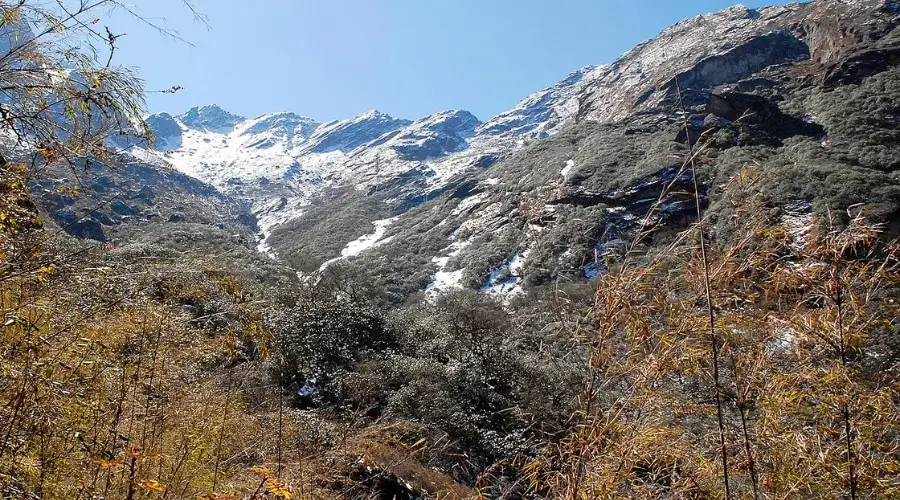
Next, we head to the high camp, spend a night in a tent, conquer Mera Peak trekking, and return along the same route.
Himalayan Masters ensures a hassle-free and quality service experience and carefully plans for acclimatization and health.
Typical Day in Mera Peak
A typical day during the Mera Peak climbing expedition starts early, around 6:00 AM. Most trekkers have tea or coffee for breakfast and some light snacks before repacking their backpacks for the day’s trekking. The trek usually begins around 7:00 AM to travel a particular distance for lunch.
In mid-afternoon, the group takes a break and rests at a beautiful place or a tea house for lunch. This is a good opportunity to have a break, eat a warm meal, and have a little nap before continuing in the afternoon. The afternoon trek is typically less lengthy as it must allow for arrival at the destination for the day by the end of the afternoon.
Trekkers relax in their rooms when arriving at the teahouse or lodge for the night. Dinner is served early, around 6:00 PM to 7:00 PM, and it is a strong Nepali meal that provides you immense diet and protein.
Important Notes for Mera Peak Expedition
- Spend adequate time acclimatizing to avoid altitude sickness, as the peak is over 6,000 meters high.
- Prepare with cardio and strength training to handle the physical demands of the climb.
- Familiarize yourself with using crampons, ice axes, and rope techniques, as you’ll encounter glacier walking and crevasses.
- Be ready for rapid weather changes; conditions can shift quickly in the mountains.
- Consider joining a guided expedition with experienced Sherpas and local guides for safety and support.
- Bring appropriate clothing and equipment for cold temperatures and high altitudes to ensure comfort and safety during the climb.
Mera Peak Climbing Altitude Scale

Climbing Mera Peak 14-day Itinerary Outline
| Day | Route | Sleep Altitude | Time |
| 01 | Kathmandu → Lukla → Chhuthang | 3020 m / 9908 ft. | 4-5 hours |
| 02 | Chhuthang → Zatrwa La Pass → Chatrabuk | 4200 m / 13,780 ft. | 5-6 hours |
| 03 | Chatrabuk → Thuli Kharka → Kothe | 3680 m / 12,073 ft. | 5-6 hours |
| 04 | Kothe → Lungsumgba Gompa → Thangnak | 4350 m / 14,271 ft. | 4-5 hours |
| 05 | Acclimatization Day at Thangnak | 4350 m / 14,271 ft. | – |
| 06 | Thangnak → Dig Kharka → Khare | 5,045 m / 16,551 ft. | 4-5 hours |
| 07 | Acclimatization Day (Climbing Prepare) | 5,045 m / 16,551 ft. | – |
| 08 | Khare → Mera La Pass → High Camp | 5,800 m / 19,029 ft. | 5-6 hours |
| 09 | High Camp → Mera Peak → Khare | 5,045 m / 16,486 ft. | 8-9 hours |
| 10 | Reserve Day for Climbing | 5,045 m / 16,486 ft. | – |
| 11 | Khare → Thangnak → Kothe | 3,691 m / 12,109 ft. | 5-6 hours |
| 12 | Kothe → Tashing Dingma → Thuli Kharka | 4,300 m / 14,108 ft. | 6-7 hours |
| 13 | Thuli Kharka → Zatrwa La Pass → Lukla | 2,860 m / 9,383 ft. | 6-7 hours |
| 14 | Lukla → Kathmandu | 1400 m/ 4593 ft. | 25 min |
ITINERARY
Day 01: Fly to Lukla and Trek to Chhuthang
Flight Route: Kathmandu → Lukla
Trek Route: Lukla → Chheplung → Thado Koshi → Chhuthang
Beginning Point: Kathmandu (1400 m / 4593 ft.)
Lunch: En Route
Ending Point/ Overnight: Chhuthang (3020 m / 9908 ft.)
Total Ascent: 1620 meters (5315 ft.)
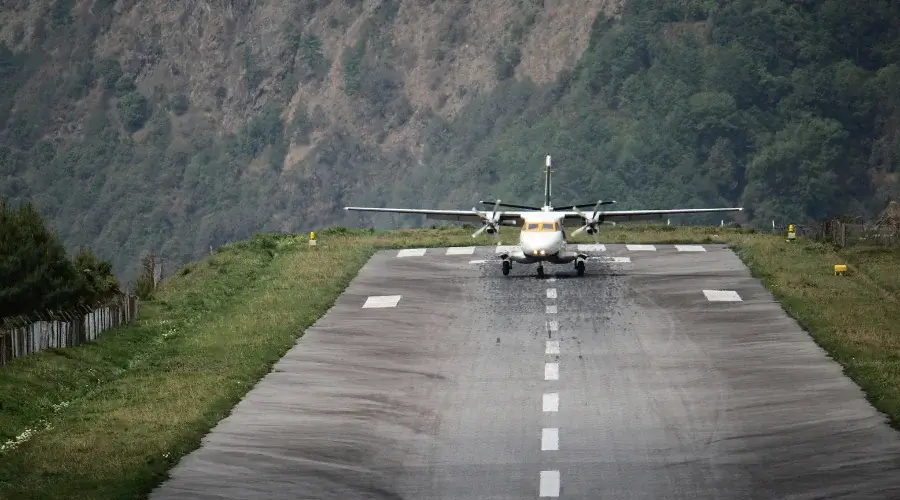
In the morning, we start the day by driving to the airport. After the paperwork, we hop on a domestic flight to Lukla. For 25 minutes, you will be delighted with parallel views of the mountain vistas. Landing on Lukla, you will be in a different landscape. Here, we met our porters and Sherpas for the first time.
After getting a local area permit here, we move towards Chhuthang. Crossing the village via the Kalo Khola ridge, we cross thick subtropical forests. In the Chhuthang, we set our first camp during the Mera Peak trip.
From Lukla, the trail to Chhuthang takes you through charming Sherpa villages and quiet forested trails. Passing through Chheplung and Thado Koshi, you’ll trek along paths that wind through rhododendron and pine forests.
The trail is moderately challenging, combining ascents and descents, and provides stunning views of the surrounding mountains.
You’ll also cross several suspension bridges, adding excitement to the journey. As you move higher, the air becomes crisper, and the landscapes transition from lush vegetation to the serene wilderness that characterizes the higher altitudes. After a fulfilling trek, you’ll arrive at Chhuthang.
About Chhuthang:
Chhuthang is a small, scenic settlement surrounded by lush forested hills, often used as an overnight stop for trekkers heading toward the Zatrwa La Pass. The area is secluded, peaceful, and a perfect location for acclimatization.
Teahouses at Chhuthang:
- You will find basic bedding with warm blankets
- Electricity for charging devices (may require a small fee)
- Wi-Fi access, though it may be slow and might come with a small fee
- Shared basic restrooms with limited hot water
Meal : Breakfast, Lunch and Dinner
Accommodation : Tea House
Walking / Driving : 25 min flight and 4-5 hours trek
Day 02: Trek from Chhuthang to Chatrabuk
Trek Route: Chhuthang → Zatrwa La Pass → Zatrwa Og → Chatrabuk
Beginning Point: Chhuthang (3020 m / 9908 ft.)
Lunch: Near Zatrwa La Pass
Ending Point/ Overnight: Chatrabuk (4200 m / 13,780 ft.)
Total Ascent: 1180 meters (3871 ft.)
Total Descent: 400 meters (1312 ft.)
From Chhuthang, we start climbing at 4,200 above sea level. Today’s steep climb at Zatrawala Pass gives you an idea about the difficulty of Mera Peak climbing. From the top of the pass, we can see Kongdi Ri, Karyolang Peak, Number Himal, and Lumding Himal.
This Zatrawala separates Khumbu and Hinku Valley during the Mera Peak trip. Then, we descend to Chatrabuk for a short time and crash at a camp there.
The path is steep and rugged, winding through alpine terrain with sparse vegetation, and offers spectacular views of the surrounding peaks.
After a short rest and some time to take in the scenery, you’ll descend toward Chatrabuk. This section requires careful navigation, as the path can be rocky and challenging.
The trek to Chatrabuk takes you through picturesque landscapes with fewer travellers, adding to the sense of adventure and isolation. Upon reaching Chatrabuk, you’ll find a welcoming teahouse to rest and recharge for the evening.
About Chatrabuk:
Chatrabuk is a high-altitude settlement primarily serving trekkers with its basic teahouse facilities. The area is quiet, with beautiful views of the surrounding rugged terrain, and is a peaceful spot for an overnight stay after the Zatrwa La Pass.
Teahouses at Chatrabuk:
- Cozy, with basic bedding and blankets
- Boiled or filtered water (available for a fee)
- Electrical charging (may require a small fee)
- Shared bathrooms with basic amenities
Meal : Breakfast, Lunch and Dinner
Accommodation : Tea House
Walking / Driving : 5-6 hours trek
Day 03: Trek from Chatrabuk to Kothe
Trek Route: Chatrabuk → Thuli Kharka → Hinku Valley → Kothe
Beginning Point: Chatrabuk (4200 m / 13,780 ft.)
Lunch: Thuli Kharka
Ending Point/ Overnight: Kothe (3680 m / 12,073 ft.)
Total Ascent: 100 meters (328 ft.)
Total Descent: 620 meters (2034 ft.)
Today’s trek descends from Chatrabuk to Kothe, guiding you from the high, barren landscape around Thuli Kharka into the vibrant Hinku Valley.
After leaving Chatrabuk, you’ll gradually descend toward Thuli Kharka, passing through rhododendron forests that burst into colour during the blooming season.
This descent can be steep in places, so it’s essential to maintain your pace and take breaks as needed. Thuli Kharka makes a great resting point, offering lunch and views of towering peaks, including Mera Peak in the distance.
Continuing from Thuli Kharka, the trail winds through parts of the Hinku Valley, known for its scenic beauty and diverse flora. As you make your way to Kothe, you’ll notice the shift in landscape from alpine slopes to lush valleys with more greenery.
The Hinku Valley is a haven for rare Himalayan birds and offers a calm, secluded atmosphere away from crowded trails. Arriving at Kothe in the late afternoon, you’ll settle into a cozy teahouse for a restful evening.
About Kothe:
Kothe is a small Hinku Valley settlement popular among trekkers heading to Mera Peak. The area is serene, with surrounding forests and streams creating a peaceful environment for trekkers to unwind.
Teahouses at Kothe:
- Basic bedding with blankets; rooms are simple but clean
- Filtered or boiled water is provided for a small fee
- Charging for electronics (often for a fee)
- Limited connectivity; paid and typically slow
- Shared bathrooms with basic amenities
Meal : Breakfast, Lunch and Dinner
Accommodation : Tea House
Walking / Driving : 5-6 hours trek
Day 04: Trek from Kothe to Thangnak
Trek Route: Kothe → Gondishung → Lungsumgba Gompa → Thangnak
Beginning Point: Kothe (3680 m / 12,073 ft.)
Lunch: Gondishung
Ending Point/ Overnight: Thangnak (4350 m / 14,271 ft.)
Total Ascent: 670 meters (2,198 ft.)
Today’s trek takes you from Kothe to Thangnak, where the trail begins to follow the Hinku Valley more closely as it narrows, guiding you through beautiful alpine terrain and rocky landscapes.
Departing from Kothe, you’ll trek along the Hinku River, surrounded by pine forests that give way to sparser vegetation as you gain altitude.
After 2-3 hours, you’ll reach Gondishung (4,270 m), a small herders’ settlement where trekkers often stop for lunch. You’ll find a traditional yak pasture and some small tea huts here.
On the way to Thangnak, a notable stop is Lungsumgba Gompa, a centuries-old Buddhist shrine. It’s a perfect spot to take a break and enjoy the serene atmosphere of the remote valley. You’ll also have views of Kusum Kanguru and surrounding peaks, which create a stunning backdrop for this spiritual location.
After leaving the gompa, the trail becomes rockier and steeper until you finally reach Thangnak. The village is a popular stop for trekkers and climbers acclimatizing to Mera Peak.
About Thangnak:
Thangnak is a small settlement serving trekkers and climbers on the Mera Peak route. Located at the base of towering peaks, it has a peaceful atmosphere and offers breathtaking mountain views.
Teahouses at Thangnak:
- Basic bedding with thick blankets; rooms are simple but comfortable
- Charging stations for electronics, usually in the dining area (fees apply)
- Limited, paid connectivity (often very slow and may not always be reliable)
- Shared bathrooms with basic amenities and hot showers are sometimes available for an additional cost.
Meal : Breakfast, Lunch and Dinner
Accommodation : Tea House
Walking / Driving : 4-5 hours trek
Day 05: Acclimatization Day at Thangnak
Thangnak is actually a very beautiful place for acclimatization. Stopping here for a day allows us to adapt to the low oxygen level. However, we keep ourselves active by exploring the nearby hills and villages. We shall burn the campfire and have awesome memories of the trip.
Meal : Breakfast, Lunch and Dinner
Accommodation : Tea House
Day 06: Trek from Thangnak to Khare
Trek Route: Thangnak → Dig Kharka → Khare
Beginning Point: Thangnak (4,350 m / 14,271 ft.)
Lunch: En route
Ending Point/ Overnight: Khare (5,045 m / 16,551 ft.)
Total Ascent: 695 meters (2,280 ft.)
Today’s trek from Thangnak to Khare takes you further up the Hinku Valley with increasing altitude and captivating views of the Mera Glacier and nearby snow-capped peaks. Starting from Thangnak, the trail follows a gradual ascent along the Dig Glacier and crosses scenic moraines.
You’ll trek through Dig Kharka, a scenic meadow area where many trekkers stop for lunch. From here, you can admire the panoramic view of Charpate Himal and surrounding mountains.
After lunch, the path steepens as you continue along the glacial moraine, with awe-inspiring views of Mera Peak looming closer with each step. The final stretch to Khare is more challenging due to the thinning air, but the trek rewards you with breathtaking scenery of the high Himalayas and the rugged terrain.
Upon reaching Khare, you’ll feel the excitement building as it serves as the base camp area for Mera Peak Amphu Lapcha Pass, with ample opportunities for acclimatization and preparation for the climb.
About Khare:
Khare is the last significant settlement on the way to Mera Peak, known for its proximity to the Mera Glacier and as a base for Mera Peak expeditions. The settlement is compact, with only a few teahouses and lodges catering to trekkers.
Teahouses at Khare:
- Single or shared rooms with blankets provided, though extra warm sleeping bags are recommended due to the cold
- Limited charging options, usually in the communal dining area (fees apply)
- Wi-Fi is available in some teahouses, but it is usually slow and for a fee
Meal : Breakfast, Lunch and Dinner
Accommodation : Tea House
Walking / Driving : 4-5 hours trek
Day 07: A day for further Acclimatization
This is our last stop before we head for the Mera Peak summit climb. We plan to take short hikes around the village and learn mountaineering skills.
In addition to the hikes, today is also a chance to review essential climbing gear and techniques. Guides often conduct training sessions to familiarize you with using crampons, ice axes, and ropes. This practice ensures you’re prepared for the technical aspects of the upcoming climb and helps boost confidence for the summit push.
The rest of the day is reserved for relaxation—replenishing energy, hydrating well, and staying warm. Since the air is thinner at this altitude, staying hydrated and taking it easy are crucial for successful acclimatization.

Meal : Breakfast, Lunch and Dinner
Accommodation : Tea House
Day 08: Trek from Khare to High Camp
Trek Route: Khare → Mera La Pass → High Camp
Beginning Point: Khare (5,045 m / 16,486 ft.)
Lunch: Mera La Pass
Ending Point/ Overnight: High Camp (5,800 m / 19,029 ft.)
Total Ascent: 755 meters (2,477 ft.)
This day’s trek from Khare to Mera Peak High Camp is one of the most exhilarating yet challenging sections of the Mera Peak journey. You will start early from Khare, ascending steadily toward the Mera Glacier.
The trail gradually gains elevation with panoramic views, and as you move closer to Mera La Pass, the climb becomes steeper, requiring cautious and steady steps on the icy terrain. The route is stunning but requires careful footwork as the path may be snow-covered or icy.
Reaching Mera La Pass, you’ll take a break here to rest and enjoy lunch while appreciating the views of Makalu, Everest, Lhotse, and Cho Oyu on the distant horizon.
After lunch, you will push to High Camp, the final stop before the Mera Peak summit. The journey from Mera La Pass to High Camp is steep and challenging, and the higher altitude makes each step more demanding, so keeping a steady pace is essential.
At High Camp, you’ll be surrounded by a dramatic landscape of ice and snow, with panoramic views that span the entire Himalayan range. It’s a quiet, remote site that offers incredible tranquillity and sets the stage for an early start toward the summit.
About High Camp:
High Camp is a rugged, high-altitude camp positioned strategically for summit attempts on Mera Peak. It has a few small, basic shelters and is surrounded by stunning vistas of Himalayan peaks, including Everest and Makalu.
Teahouses/Camping at High Camp:
- Limited space with tented camps or stone shelters; basic but adequate shelter against the extreme weather
- Meals are generally prepared by the trekking crew, including energy-rich foods to prepare for the climb
- Boiled or purified water is usually provided, but supplies are limited at this altitude
- Charging and wifi are unavailable
Meal : Breakfast, Lunch and Dinner
Accommodation : Tent
Walking / Driving : 5-6 hours trek
Day 09: Climb to Mera Peak and back to Khare
Climb Route: High Camp → Mera Peak → Return to Khare
Beginning Point: High Camp (5,800 m / 19,029 ft.)
Summit Point: Mera Peak (6,476 m / 21,247 ft.)
Lunch: Packed meal near the summit
Ending Point/ Overnight: Khare (5,045 m / 16,486 ft.)
Summit Climb: 4-5 hours
Descent to Khare: 3-4 hours
Total Ascent: 676 meters (2,218 ft.)

This will be the longest and the hardest day of our Mera peak climb. We start the hike while it’s still dark and start walking with the help of a torch. As the sun rises, we can see the golden range of the mountains smiling at us. Climbing to Mera Peak at High camp altitude is challenging.
The climb begins with a steady but steep ascent across a glacier, where you’ll use ropes and crampons as necessary. The last part of the climb is very steep, and you need to be careful with the instructions.
Getting to the top, you can see the views of Everest, Makalu, Lhotse, Cho Oyu, and Kanchenjunga. We plan to reach the summit before midday as the wind after that is powerful. Then, we walk for about four hours to Khare.
Meal : Breakfast, Lunch and Dinner
Accommodation : Tea House
Walking / Driving : 8-9 hours trek
Day 10: Reserve Day for Climbing
This reserve day is strategically planned to allow flexibility in case of challenging weather conditions, unforeseen delays, or acclimatization issues during the summit attempt.
If conditions prevent summiting on Day 9, this day serves as a buffer to maximize chances for a safe and successful climb. It’s a vital part of high-altitude climbing itineraries, allowing climbers a chance to wait for better conditions or recuperate before another summit attempt.
If you successfully summited on Day 9, today becomes a rest and recovery day at Khare. You can take the time to relax, recover, and share stories with other trekkers.
Many climbers use this day to explore around Khare, photograph the stunning landscapes, and enjoy hot meals while unwinding after the physically intense summit day.
Meal : Breakfast, Lunch and Dinner
Accommodation : Tea House
Day 11: Trek from Khare to Kothe
Trek Route: Khare → Thangnak → Kothe
Beginning Point: Khare (5,045 m / 16,486 ft.)
Lunch: Thangnak
Ending Point/ Overnight: Kothe (3,691 m / 12,109 ft.)
Total Descent: 1,354 meters (4,448 ft.)
After the intense climbing days, today’s trek takes you back down to the familiar green pastures of Kothe. The descent from Khare provides a relatively easy trek as you head to lower elevations, making breathing and walking comfortably easier.
The trail retraces the rocky paths and stunning glaciers you crossed earlier, offering new perspectives on the beautiful Hinku Valley as you descend.
As you pass through Thangnak, you’ll enjoy a mid-day break and have lunch while taking in scenic views of the Mera Peak towering above. The trail then continues towards Kothe, passing through lush rhododendron forests and glacial rivers that add to the landscape’s natural beauty.
You’ll reach Kothe in the afternoon, where you can relax in one of the teahouses, recounting stories of your summit and celebrating with other trekkers.
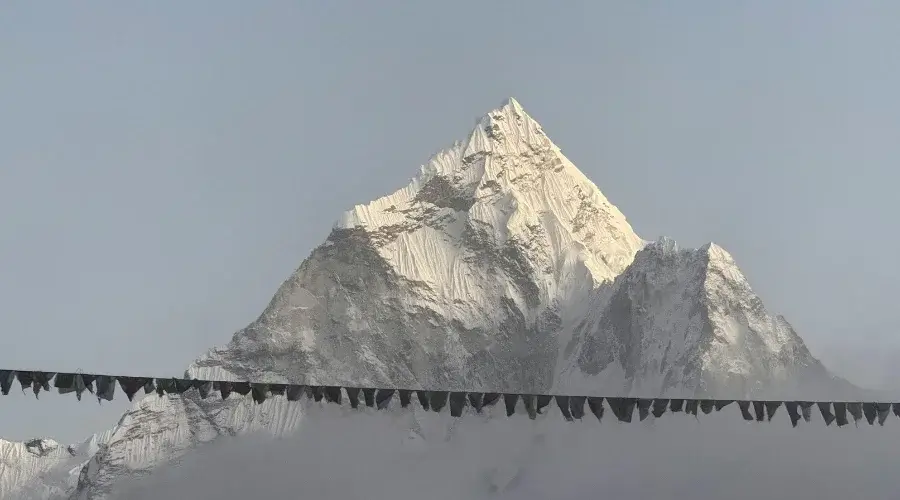
Meal : Breakfast, Lunch and Dinner
Accommodation : Tea House
Walking / Driving : 5-6 hours trek
Day 12: Trek from Kothe to Thuli Kharka
Trek Route: Kothe → Tashing Dingma → Thuli Kharka
Beginning Point: Kothe (3,691 m / 12,109 ft.)
Lunch: En Route
Ending Point/ Overnight: Thuli Kharka (4,300 m / 14,108 ft.)
Total Ascent: 609 meters (1,999 ft.)
Today’s trek from Kothe to Thuli Kharka involves a steady ascent as you make your way up through the Hinku Valley. You’ll begin with a climb through dense rhododendron and juniper forests, which are vibrant during the flowering seasons.
The trails become more rugged and steep as you gain altitude, with breathtaking views of Mera Peak and other Himalayan ranges gradually coming into view.
As you approach Thuli Kharka, the landscape becomes more open, revealing expansive views of surrounding valleys, peaks, and lush vegetation.
About Thuli Kharka:
Thuli Kharka has scenic views of the nearby peaks and a sense of calm and remoteness that climbers and trekkers often seek. The teahouses here are well-equipped for a cozy stay as trekkers prepare for the high pass.
Teahouses in Thuli Kharka:
- Basic rooms with shared accommodation, equipped with warm blankets and sturdy beds.
- Variety of warm drinks such as tea, coffee, and herbal drinks.
- Charging facilities are available, generally for a small fee.
- Limited internet access; availability may vary by teahouse.
- Hot showers are available at an extra charge.
Meal : Breakfast, Lunch and Dinner
Accommodation : Tea House
Walking / Driving : 6-7 hours trek
Day 13: Trek from Thuli Kharka to Lukla
Trek Route: Thuli Kharka → Zatrwa La Pass → Chutanga → Lukla
Beginning Point: Thuli Kharka (4,300 m / 14,108 ft.)
Lunch: Chhutang
Ending Point/ Overnight: Lukla (2,860 m / 9,383 ft.)
Total Descent: 1,440 meters (4,725 ft.)
On the final day of your trek, you will depart from Thuli Kharka and make your way to Lukla. The day begins with a challenging ascent to the Zatrwa La Pass.
After enjoying the breathtaking vistas from the past, you will descend through lush rhododendron forests and beautiful landscapes. The trail is well-marked, allowing for a comfortable descent as you pass through several scenic spots and perhaps encounter local wildlife.
You’ll stop for lunch at Chhutang, where you can refuel and enjoy the serene environment. Afterwards, continue your trek towards Lukla.
As you approach the village, the atmosphere becomes lively with the sights and sounds of local shops, teahouses, and the hustle of trekkers arriving and departing.
About Lukla:
Lukla is the gateway to the Everest region, bustling with energy and activity. It is known for its small airport, the Tenzing-Hillary Airport, and is a popular base for trekkers heading to various destinations, including Everest Base Camp and Gokyo Lakes.
Meal : Breakfast, Lunch and Dinner
Accommodation : Tea House
Walking / Driving : 6-7 hours trek
Day 14: Fly from Lukla to Kathmandu
Flight Route: Lukla → Kathmandu
Beginning Point: Lukla (2860 m/ 9383 ft.)
Ending Point/Overnight: Kathmandu (1400 m/ 4593 ft.)
Fly Distance: 136 km
Total Descent: 1460 meters
The flight from Lukla to Kathmandu is usually scheduled in the morning. If the weather is unstable, we might have to stop here for a few days. From Lukla, we fly to Kathmandu airport in only 25 minutes.
At the airport, a driver will already be waiting for your arrival. Arriving at Thamel, you will have time to recover from the trek. Also, take some time aside for souvenir shopping.
Meal : Breakfast
Accommodation : Hotel
Walking / Driving : 25 min flight and 30 min drive
include / exclude
Trip Cost Includes
- International airport pick-up and drop-off by private car.
- A three-night hotel in Kathmandu with breakfast.
- A professional English-speaking trekking guide during the trekking.
- An experienced porter during the trek.
- Breakfast, Lunch and dinner during your trekking and expedition.
- Basic twin-sharing tea house accommodations In the mountains.
- Sagarmatha National Park permits.
- Mera peak permits.
- Kathmandu to Lukla to Kathmandu airfare.
- Guide Flight Ticket.
Mera Peak climbing Cost includes
- A one-night tent stay at the Mera Peak High Camp.
- Breakfast, lunch, and dinner during base camp and high camp, and tea and coffee are unlimited.
- A climbing 2 sherpas (private guide) for 3 clients.
- Guide insurance.
The Complimentary service from The Himalayan Masters
- A 25-degree sleeping bag during the trip.
- Down jacket during the trip.
- Water bottles and purification tablets.
- First aid kit box.
- Himalayan Masters Brand Duffle Bag for the Trip.
- Himalayan Masters Brand Trekking T-Shirt and Cap.
- Farewell dinner in Kathmandu by the Himalayan Masters Team.
- Climbing gears for the Mera Peak Climb.
Trip Cost Excludes
- An international flight ticket.
- Tips for Climbing guides, porters and base camp staff.
- Lunch and dinner in the city.
- Wi-Fi, battery charging, and hot showers in the mountains.
- Travel Insurance.
- Other personal expenses.
Other things that have not been mentioned above are also on the exclusion list.
useful info
Altitude Sickness During Mera Peak Expedition
As with all high-altitude treks, the Mera peak trekking also risks altitude sickness. The sudden shift of altitude from Kathmandu to Lukla (1400 m to 2860 m) can be troublesome for anyone. As you climb to the Mera Peak altitude of 6476 meters, air pressure can take a toll on the human body and increase the Mera Peak difficulty.
Acute Mountain Sickness (AMS) causes symptoms such as nausea, insomnia, loss of appetite, and diarrhea. These symptoms can be moderate for some and fatal for others. In severe cases, you may need to walk back to a lower altitude and even require a helicopter due to extreme conditions. We don’t suggest climbing at Mera peak elevation for solo trekkers.
Mera Peak Technical Difficulty
Trekking Mera Peak also demands technical climbing skills. But you don’t need this training beforehand- the guide will teach you simple ways to use crampons, ropes, and axes before you head for the trek.
In a single trip, some people also include Mera Peak and Island Peak or Mera Peak and Lobuche Peak climbing. Before you do that, we suggest analyzing Mera Peak vs Island Peak and then climbing one at a time. With a responsible team, you are likely to be fine.
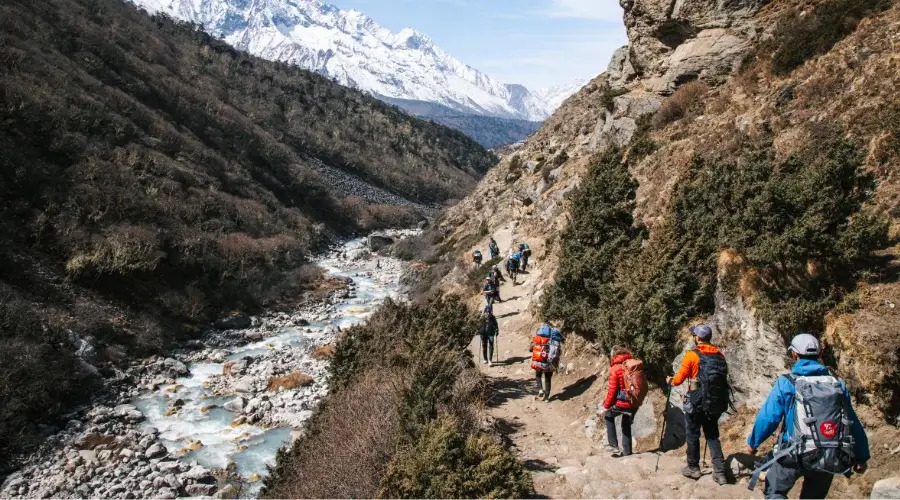
Mera Peak Climbing Permit and Its Cost
Do you need a permit to climb Mera Peak? Yes, you do need a Mera Peak Permit. This permit is required for all climbers and can be obtained through a registered trekking agency in Nepal.
The permit ensures climbers can legally enter the region and ascend the peak. It’s important to arrange this permit before starting your trek to avoid any issues during your expedition. Summiting the Mera Peak expedition requires Mera Peak permit costs to vary by season.
- Spring (Mar-Apr-May) costs USD 250
- Autumn (Sep-Oct-Nov) USD 125
- Winter (Dec-Feb) USD 70, and
- Summer (Jun-Jul-Aug) USD 70.
- Additionally, a USD 250 garbage charge is collected (mandatory).
- National park permits for Sagarmatha and Makalu Barun cost USD 30 each.
- A local community fee of NPR 2000 supports trail improvement during the Mera Peak Climbing.
Mera Peak Emergency and Evacuation
Lukla has a hospital and an airport for your rescue if there’s an emergency during your Mera Peak Climbing. Evacuating someone by helicopter depends on the Mera peak weather and visibility.
In an emergency, the team, guide, and nearby helpers will work together to move the person to a safe spot.
Helicopter evacuation can be organized through your insurance, but you must talk directly to the insurance company. To do this, share your policy number, name, address, and the date you paid for the insurance policy.
What should I pack to climb Mera Peak?
Climbing Gear
- Climbing Boots
- Crampons
- Ice Axe
- Harness
- Climbing Helmet
- Climbing Ropes
Clothing
- Base Layers (moisture-wicking)
- Insulating Layers (fleece or down jacket)
- Waterproof Jacket and Pants
- Warm Hat
- Gloves
Camping Gear
- Tent
- Sleeping Bag (sub-zero rated)
- Sleeping Pad
- Headlamp
Medical Supplies
- First Aid Kit
- Altitude Sickness Medication
Navigation and Communication
- Map and Compass
- GPS Device or Smartphone
Miscellaneous
- Trekking Poles
- Sunscreen
- Lip Balm
Footwear and First Aid Considerations
Choose boots that fit well, are warm, and allow crampon use. B1-graded boots are suitable for climbing Mera Peak. Keep your first aid kit simple with pain relievers, wound care items, antihistamines, sun protection, and medications as needed.
Include altitude sickness prevention like acetazolamide tablets (Diamox) with a prescription. With these essentials, you’ll be well-prepared for a safe and comfortable climb to Mera Peak.
Best Season for Mera Peak Climbing
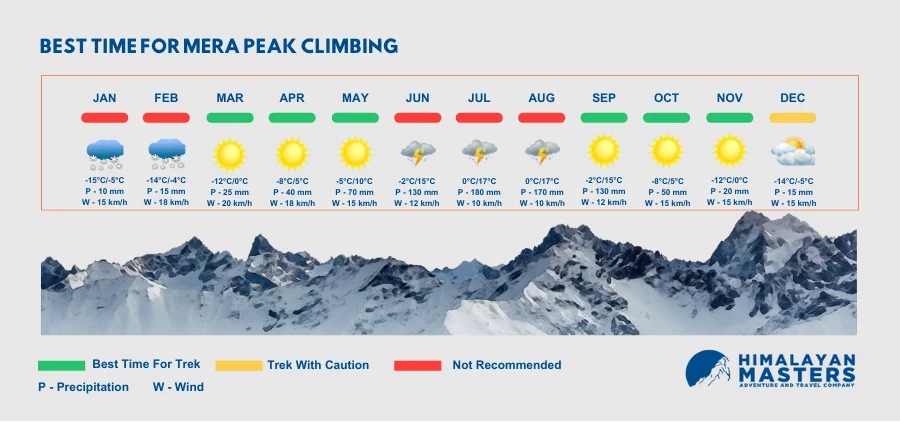
Let’s talk about Mera Peak weather. Choosing the best time to climb Mera Peak is crucial, considering the four seasons.
Due to stable weather conditions, spring and autumn are the best periods. During spring (March to May), nature rejuvenates, and the Mera peak weather is warm, making the climb enjoyable.
Autumn (September to November) is even more favourable, offering clear weather, low chances of sudden changes, and a festive atmosphere in Nepal.
Winter (December to February) is an adventurous option, with chilly Mera peak temperatures but less crowded routes.
Climbing in monsoon (June to August) is not recommended due to heavy rainfall and muddy trails, but early June or late August might provide clearer skies after the rain.
What type of Accommodation should I expect while climbing Mera Peak?
Mera Peak climbing has three kinds of accommodation depending on the season and route.
1. Hotels in Thamel, Kathmandu:
The first one is hotels in Kathmandu. You will visit three-star hotels in Kathmandu that are pretty luxurious and have all the necessary amenities.
You can have an attached bathroom in the room with a hot shower. Also, there are other unlimited options for hotels in Thamel, and you can switch to higher facilities of your own.
2. Tea houses/ Local Lodges:
In the lower region, i.e., up to Namche, we will be staying in tea houses—small yet comfortable local lodges. The rooms only have two single beds, a mattress, pillows, and a clean white sheet. However, the option of a tea house is only available for the lower region.
3. Mera Peak Base Camps:
In the higher region, above Namche, we stay in a tent/ camp. We will primarily carry all your food and accommodation for the 17-day climb of Mera Peak Nepal. The porters from Himalayan Masters will help you take everything to the camp and set up the tent for the night. The cooks will prepare your food, and you can trek easily.
Trekkers can choose any accommodation at a lower altitude—the tea house or the camps. But as we move higher, we cannot find the tea houses and thus stick with the camps. Camping in Nepal can be tricky (and expensive), but it’s a true adventure into nature.
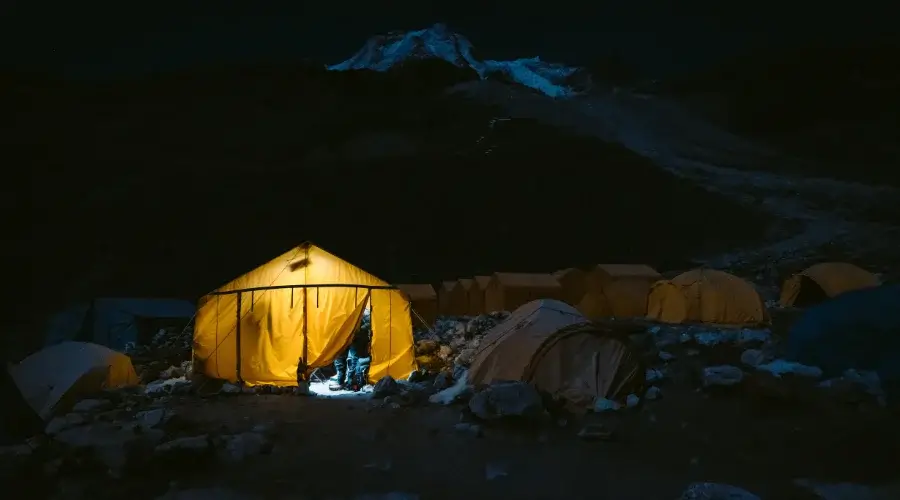
What foods are available during the trek?
Breakfast
Some breakfasts are oatmeal or porridge since they are some of the most filling and are usually served warm. Porridge mixed with jam or pancakes with jam is also a good choice, as are boiled or scrambled eggs.
Lunch
Cheese, vegetables, or meat fillings are perhaps the most popular sandwiches since they are easy to prepare and will give you full satisfaction—noodles or pasta to give the warmth of a good meal and rice with dal.
Dinner
Rice and Dal with vegetables and meat make up a good meal. Curry dishes – chicken, vegetable or fish are also preferred due to their variety and heart-warming texture.
Travel Insurance
It can be highly advisable to take travel insurance that includes high-altitude trekking and climbing, such as the Mera Peak activity. This insurance should also cover emergency medical evacuation since this can be costly, especially in the remotest part of the country.
Do I Need Additional Expenses?
However, several other expenses must be considered when planning the trekking trip. These may include ranger fees, equipment hire, porter and guide tips, additional food and beverages, communications and internet fees, and souvenirs.
Can I find an ATM service along the trek route?
While ATMs are in Kathmandu, Lukla and Namche Bazaar. So, carrying enough cash for your trek is advisable, as ATM availability can be limited and unreliable. Most teahouses along the trekking route do not take credit cards, so cash is the preferred form of payment.
Can I exchange money en route?
Other critical preparation for the trek involves the issue of money exchange. The money exchange can be done in major cities like Kathmandu, where banks are available together with other authorized exchange counters that give good rates.
You may also use online currency converters for convenience to estimate the current rate; however, this is just an approximation. Furthermore, remember that there are no money exchange facilities in some areas where you will go trekking, so it is better to change sufficient currency before you begin your trek.
Electricity & Battery Recharge Facilities
You will find electricity and battery recharge during the trek regions. But do not expect a very good connection since we are heading towards a remote part. The charges are somewhere around 1 to 2 dollars per hour. The highly recommended thing is to bring a power bank that is fully equipped with enough battery life during the trek.
Additionally, since Nepal uses types C, D, and M plugs, bringing a universal travel adapter is essential for compatibility with local sockets. For those who prefer to stay off the grid, consider a solar charger, which is especially useful in areas where electricity is scarce.
Importance & uses of water en route
Hydration is also very important during Mera Peak climbing. Bottled water can be bought along the trekking route in the tea houses, but it costs from 2 to 4 dollars per bottle, which is very expensive. Bringing a water bottle will save some money and reduce plastic garbage.
Most tea houses will provide boiled or purified water for your refill needs. The higher you go, the more restricted water sources will be. You must bring enough water to your climb. Constantly drink to avoid dehydration.
What communication should I expect?
SIM card
Therefore, buying a Nepalese SIM card upon arrival in Kathmandu will facilitate your communication during the trek. Service providers like Ncell and NTC offer highly competitive prices and good availability across many places.
Usually, one SIM card costs about 1 dollar, and data packages range from 1 to 4 dollars, depending upon the necessities.
Landline
Landline services are hardly available in far-flung areas in most parts of the route to Mera Peak. Most communications depend on mobile phones.
Post Service
A postal service is available but very slow and sometimes unreliable. In larger towns like Lukla, it is possible to send a post, but expect delays since this is a very remote region.
Walkie-talkies
These work as a substitute for walkies for connecting with the group on a trek where the cellular networks work poorly. Our guides carry a walkie-talkie with them for better communication.
Wi-Fi/Internet
Wi-Fi access is limited on the Mera Peak climb. Many tea houses have Wi-Fi for around $5, but connectivity is spotty and slow since this location is truly remote.
It is best if family or friends know this before you leave on your trek. Individuals needing continued connectivity should bring a local SIM card for mobile data.
Precautions for Safety and Security
Safety during climbing Mera Peak is the priority. Never trek without taking a well-seasoned guide who can navigate difficult-to-follow paths and help minimize altitude sickness or handle it should that occur.
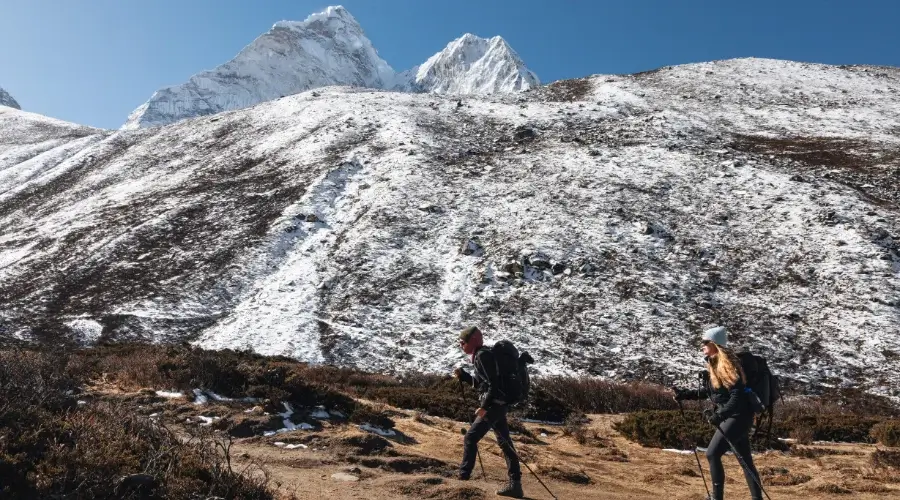
Come properly equipped for high altitude and with knowledge of safety precautions, acclimatization, and hydration. High-altitude trekking insurance will be quite necessary for the peace of mind it offers.
Guided vs Non-Guided
Climbing with a guide is highly recommended for Mera Peak due to its challenging terrain and altitude. With the proper guidance of the guide, it will be easier to navigate the terrains.
But if you want to trek solo, you need to be extra careful with each and everything during the trek.
Porters Versus No Porter
In this scenario, hiring porters can be considered good. Porters or carriers transport large loads of camping equipment and food supplies up the mountain. That way, climbers focus less on logistics and the physical fatigue involved in their ascent. Others prefer carrying everything on their person for a more personal experience and challenge.
Tips to Hire a Porter for Climbing
When you decide to hire a porter, it is always better to hire the one the company provides. But if you don’t want to do it, you must get enough information about his or her experience. Also, knowing about their charges and fitness level helps make the trek better.
Tipping Culture for Guides and Porters
It is well practised in Nepal to tip guides and porters who serve well during treks and climbs like Mera Peak. A good guide generally deserves tipping about 10% of the total cost of your trip, or US$ 10-20 per day, and for the porter.
Alternative Trekking Routes
Other trails lead to Mera Peak, which is less crowded and provides different experiences. Some are the Everest Three Pass Trek, Gokyo Lakes Trek, and Island Peak Climbing.
Extending Trips
You may extend the expedition period in the Everest Region by including nearby summits, such as Island Peak, or merely visiting rural villages for cultural experiences like Namche Bazaar or Lukla.
For those looking to go outside the region, consider visiting Annapurna or Langtang Valley for diverse trekking experiences showing Nepal’s rich natural beauty.
Mera Peak vs Island Peak | Which is Easy?
Two climbing destinations in Nepal are Mera Peak and Island Peak, which have an adventurous feel. Mera deserves its reputation as the highest trekking peak in the Khumbu area since it stands 6,476 meters or 21,246 feet tall.
It is relatively easy to scaler and does not need any skills, just the basic fitness level of a climber. Climbing is mostly done in the snow, and it is done by walking.
On the other hand, it is much higher, 6,189 meters (20,305 feet) and a little more difficult than the previous peak. Climbers must traverse crevasses and a sharp pitch’ area towards the top of the cliff.
Mera Peak has a comparatively difficult approach trail, mostly over rocks, while the Island Peak approach trail is easier and is used primarily for reaching the main Everest trail. Island Peak has excellent visibility of the Himalayas, especially from the top two peaks, giving views of the Himalayas in general.
How to Book with Himalayan Masters
Booking with Himalayan Masters includes several easy steps:
- Visit our website.
- Choose your desired trekking package.
- Please leave an inquiry form or contact them.
- Pay your deposit to confirm your reservation.
- Follow their preparatory instructions before your trip.
How Can I Book a Trip at the Last Minute?
In case of urgent bookings, you are required to contact the Himalayan Masters directly by telephone or email. Depending on your time availability and existing bookings, they will assist you in arranging a quick journey, considering your time factor.
Why Choose Himalayan Masters
Himalayan Masters is distinguished for having experienced guides, personal itinerary preparation, and programmed safety during climbs, such as Mera Peak. Their good service allows clients to remember their mountain experience and ensures their safety on difficult terrain.
Cancellation Policy
Himalayan Masters has a good cancellation policy. You do not get a refund of the deposited amount, but you can use the deposited money while travelling in Nepal for a lifetime. It does not expire. You can even bring your friends and loved ones to use it.
Feedback/Review
Providing feedback after the trip will help them serve better for other trekkers. Most of you can share on TripAdvisor and other platforms to help others choose Himalayan Masters, a better trekking agency.
Benefits of Booking with Himalayan Masters
- Enjoy a straightforward and efficient booking process.
- Benefit from 24/7 support, airport pick-up, and pre-trip briefings for a smooth experience.
- Access essential trekking equipment and free luggage storage during your trek.
- You will also get complimentary t-shirt, caps, duffle bags and water purification tablets too.
Reviews
Himalayan Masters have been fantastic! I travelled solo to Nepal to summit Mera Peak in April 2024 and could not have had a better experience. Sandip is amazing and was so helpful in organising every aspect of our trip. Our guide, Gobinda, was very knowledgeable about the region and took great care of a team member who suffered from altitude sickness.
I felt completely safe throughout the trip, and Gobinda made it so much fun, even when times were tough! Our porter, Brindra, was also incredible and helped us carry our bags to High Camp; we could not have done it without him. I highly recommend trekking and climbing with Himalayan Masters, the best company in Nepal!
Jess BrownUSA
We had a great time together on the Mera Peak trek. Sandip, the organiser, did a perfect job of giving us the best service, and even when my luggage didn’t arrive in Lukla, he was a helping hand I could count on!
Simon LAustralia
Gobinda, our Guide, and Birendra, our Porter, were fantastic. Always thoughtful, strong and never pushing or stressed. They gave us all the time we needed and helped in every scenario. We became good friends, and I hope to see them again soon.
I really recommend Himalayan Masters and all the ones involved. They are great in what they do!
FAQs
Can beginners climb Mera Peak?
Yes, Mera Peak is a trekking peak that the beginner’s trekkers can complete. It would help if you had some technical climbing training and acclimatization before the trek, but after some preparation, it is definitely possible for a newbie to complete this trek.
Is Mera Peak Better than the Everest Base Camp?
Can you see Everest From Mera Peak?
Is Mera Peak worth it?
Is Mera Peak a technical climb?
Can I climb Mera Peak without a guide?
What is Mera Peak's success rate?
How do I prepare for the Mera Peak trek?
How many days do you need for Mera Peak?
Can you climb Mera Peak Solo?
What is the elevation gain of Mera Peak?
What are the fees and documents required to get a Nepal Visa?
Will I get hotel transfers during my arrival and departure?
How long is the Mera Peak climbing?
Do we need to carry an oxygen cylinder and Gamow Bag?
Should I carry any extra cash during Mera Peak's Journey?
How much to tip a guide or porters? Is it necessary?
What kind of food should I expect during the trek?
What internet/telephone services are possible on the Mera Peak Expedition?
Is Mera Peak harder than Island Peak?
What mountains can you see from Mera Peak?
What is the climbing cost for Nepali climbers?
Is there a risk of avalanches on Mera Peak?
What is the altitude of Mera Peak High Camp?
Speak to an Expert





Sandip Dhungana
Nepal 🇳🇵
Whatsapp: +977-9823636377
Speak to an Expert





Sandip Dhungana
Nepal 🇳🇵
Whatsapp: +977-9823636377



